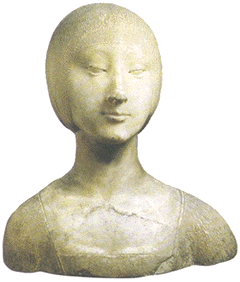...Best of Sicily presents... Best of Sicily Magazine. ... Dedicated to Sicilian art, culture, history, people, places and all things Sicilian. |
by Antonella Gallo | |||
Magazine Index Best of Sicily Arts & Culture Fashion Food & Wine History & Society About Us Travel Faqs Contact Map of Sicily
|
He was probably influenced somewhat by artistic style of the innovative master painter Piero della Francesca, who occasionally collaborated with his cousin, the architect Luciano Laurana. It is believed tha Francesco Laurana met Piero della Francesca in Rome. Little was generally known of Laurana until the nineteenth century, when art historians in several countries attempted to consolidate their knowledge of his life and work. The life of an artist was itinerant by nature, and Laurana spent much of his professional life in France, the Kingdom of Naples and the Kingdom of Sicily. The Italian realms were ruled by the Aragonese dynasty, namely Aphonse II and then his successors John and Ferdinand "the Catholic " (the monarch who financed Christopher Columbus).
In 1453, Laurana was commissioned by King Alphonse of Aragon to create the decoration of Castelnuovo at Naples, where he probably designed the gatehouse. From 1461 to 1466, he worked in France for René Duke of Anjou, a rival claimant to the Neapolitan throne. He set up a workshop in Sicily by 1468, and oversaw such projects as the sculpted archway entrance to the Mastrantonio chapel in the Church of San Francesco d'Assisi in Palermo. Among Laurana's subjects were Battista Sforza, Ippolita Maria Sforza, Beatrice of Aragon and Eleonora of Aragon (shown here), whose figure is housed in the Regional Gallery of Sicily in Palermo's Palazzo Abatellis Gallery. Laurana's minimalist approach evokes an aristocratic elegance created by the emphasis of simple geometric forms. Prominent features are expressed while others are minimized. Details are kept to the most essential ones needed to present the subject. Though each Renaissance artist certainly had his own unique style, Laurana's obvious departure from convention into the realm of individuality was a radical artistic philosophy in its day. His last works, executed in France, are said to reflect a certain northern realism. Francesco Laurana is strongly identified with Sicily, and was a contemporary of Antonello da Messina, also an innovator, whose style, with Laurana's, may be said to constitute a minor artistic movement. Laurana died in Avignon around 1502. About the Author: Antonella Gallo, who teaches art in Rome, has written numerous articles on arts and artists for Best of Sicily. | ||
Top of Page |
 His portraiture in soft marble is a sculpture that
captures the spirit of the French and Spanish kings and queens who ruled over the kingdoms of Naples and Sicily in the
waning decades of the Middle Ages, and the first years of the budding movement that came to be known as the Renaissance.
Francesco Laurana was born around 1430 in Vrana (or Urana), Dalmatia (now in Croatia), then part of the Republic of
Venice, possibly of Venetian parentage. (His Latinized name, de la Vrana, alluded to the place of his birth.) He
is best known for his stylized portrait busts of royalty, including several personages whose names are all but lost in
the complicated annals of history. Laurana also designed medals, some of which survive, as well as some bas-reliefs and
architectural works.
His portraiture in soft marble is a sculpture that
captures the spirit of the French and Spanish kings and queens who ruled over the kingdoms of Naples and Sicily in the
waning decades of the Middle Ages, and the first years of the budding movement that came to be known as the Renaissance.
Francesco Laurana was born around 1430 in Vrana (or Urana), Dalmatia (now in Croatia), then part of the Republic of
Venice, possibly of Venetian parentage. (His Latinized name, de la Vrana, alluded to the place of his birth.) He
is best known for his stylized portrait busts of royalty, including several personages whose names are all but lost in
the complicated annals of history. Laurana also designed medals, some of which survive, as well as some bas-reliefs and
architectural works.